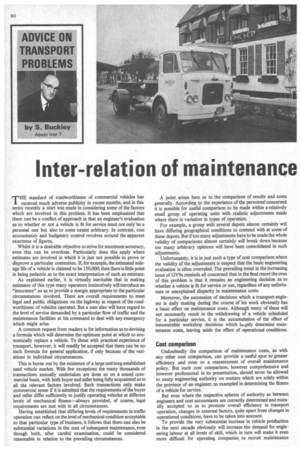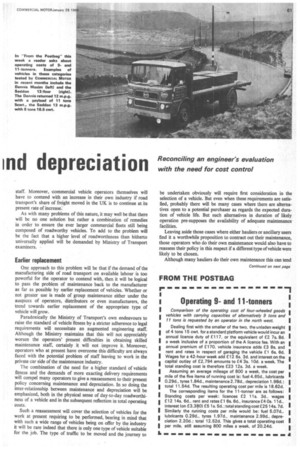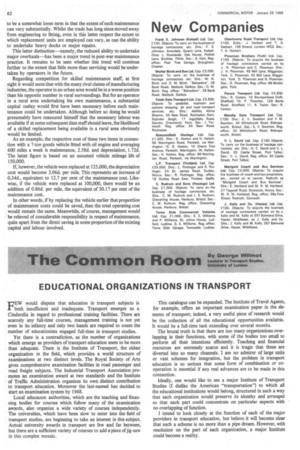Inter-relation of maintenance Ind depreciation
Page 62

Page 63

Page 64

If you've noticed an error in this article please click here to report it so we can fix it.
Reconciling an engineer's evaluation with the need for cost control
rr HE standard of roadworthiness of commercial vehicles has received much adverse publicity in recent months, and in this series recently a start was made in considering some of the factors which arc involved in this problem. It has been emphasized that there can be a conflict of approach in that an engineer's evaluation as to whether or not a vehicle is fit for service must not only be a personal one but also to some extent arbitrary. In contrast, cost accountancy and budgetary control revolves around the apparent exactness of figures.
Whilst it is a desirable objective to strive for maximum accuracy, even this can be overdone. Particularly does this apply where estimates are involved in which it is just not possible to prove or disprove a particular contention. If, for example, the estimated mileage life of a vehicle is claimed to be 150,000, then there is little point in being pedantic as to the exact interpretation of such an estimate.
As explained earlier, it is virtually inevitable that in making estimates of this type many operators instinctively will introduce an "insurance" so as to provide a margin appropriate to the particular circumstances involved. There are overall requirements to meet legal and public obligations on the highway in respect of the roadworthiness of vehicles operated. But a user also will have regard to the level of service demanded by a particular flow of traffic and the maintenance facilities at his command to deal with any emergency which might arise.
A common request from readers is for information as to devising a formula which will determine the optimum point at which to economically replace a vehicle. To those with practical experience of transport, however, it will readily be accepted that there can be no such formula for general application, if only because of the variations in individual circumstances.
This is borne out by the existence of a large and long-established used vehicle market. With few exceptions the many thousands of transactions annually undertaken are done so on a sound commercial basis, with both buyer and seller being fully acquainted as to all the relevant factors involved. Such transactions only make commercial sense if it is admitted that the requirements of the buyer and seller differ sufficiently to justify operating vehicles at different levels of mechanical fitness—always provided, of course, legal requirements are met with in all circumstances.
Having established that differing levels of requirements in traffic operation can reflect on the level of mechanical condition acceptable to that particular type of business, it follows that there can also be substantial variations in the cost of subsequent maintenance, even though both, after careful examination, could be considered reasonable in relation to the prevailing circumstances. A point arises here as to the comparison of results and costs generally. According to the experience of the personnel concerned it is possible for useful comparison to be made within a relatively small group of operating units with realistic adjustments made where there is variation in types of operation.
For example, a group with several depots almost certainly will have differing geographical conditions to contend with at some of these depots. But if too many adjustments have to be made the whole validity of comparisons almost certainly will break down because too many arbitrary opinions will have been consolidated in such adjustments.
Unfortunately, it is in just such a type of cost comparison where the validity of the adjustments is suspect that the basic engineering evaluation is often overruled. The prevailing trend in the increasing issue of GV9s reminds all concerned that in the final resort the crux of this problem is that it remains an engineering decision as to whether a vehicle is fit for service or not, regardless of any unfortunate or unexplained disparity in maintenance costs.
Moreover, the succession of decisions which a transport engineer is daily making during the course of his work obviously has a basic effect on maintenance costs. Although many of these will not necessarily result in the withdrawing of a vehicle scheduled for a particular service, it is the accumulation of the effect of innumerable workshop decisions which laigely determine maintenance costs, leaving aside the effect of operational conditions.
Cost comparison
Undoubtedly the comparison of maintenance costs, as with any other cost comparison, can provide a useful spur to greater efficiency and even to a reassessment of overall maintenance policy. But such cost comparison, however comprehensive and however professional in its presentation, should never be allowed to usurp engineering authority on matters which are solely within the province of an engineer, as exampled in determining the fitness of a vehicle for service.
But even where the respective spheres of authority as between engineers and cost accountants are correctly determined and mutually accepted so as to promote overall efficiency in transport operation, changes in external factors, quite apart from changes in operational conditions, have to be taken into account.
To provide the very substantial increase in vehicle production in the next decade obviously will increase the demand for engineering labour at all levels of skill, which in turn will make it even more difficult for operating companies to recruit maintenance
staff. Moreover, ,commercial vehicle operators themselves will have to contend with an increase in their own industry if road transport's share of freight moved in the UK is to continue at its present rate of increase:
As with many problems of this nature, it may well be that there will be no one solution but rather a combination of remedies in order to ensure the ever larger commercial fleets still being composed of roadworthy vehicles. To add to the problem will be the fact that a higher level of roadworthiness than hitherto universally applied will be demanded by Ministry of Transport examiners.
Earlier replacement One approach to this problem will be that if the demand of the manufacturing side of road transport on available labour is too powerful for the operator to contend with, then it will be logical to pass the problem of maintenance back to the manufacturer as far as possible by earlier replacement of vehicles. Whether or not greater use is made of group maintenance either under the auspices of operators, distributors or even manufacturers, the trend towards earlier replacement of the appropriate type of vehicle will grow.
Paradoxically the Ministry of Transport's own endeavours to raise the standard of vehicle fitness by a stricter adherence to legal requirements will necessitate an augmented engineering staff. Although the Ministry maintains that this will not appreciably worsen the operators' present difficulties in obtaining skilled maintenance staff, certainly it will not improve it. Moreover, operators who at present have overcome this difficulty are always faced with the potential problem of staff leaving to work in the private car side of the maintenance industry.
The combination of the need for a higher standard of vehicle fitness and the demands of more exacting delivery requirements will compel many operators to give a reassessment to their present policy concerning maintenance and depreciation. In so doing the inter-relationship between maintenance and depreciation will be emphasized, both in the physical sense of day-to-day roadworthiness of a vehicle and in the subsequent reflection in total operating costs.
Such a reassessment will cover the selection of vehicles for the work at present requiring to be performed, bearing in mind that with such a wide range of vehicles being on offer by the industry it will be rare indeed that there is only one type of vehicle suitable for the job. The type of traffic to be moved and the journey to
be undertaken obviously will require first consideration in the selection of a vehicle. But even when these requirements are satisfied, probably there will be many cases where there are alternatives open to a potential purchaser as regards the expected duration of vehicle life. But such alternatives in duration of likely operation pre-supposes the availability of adequate maintenance facilities.
Leaving aside those cases where either hauliers or ancillary users find it a worthwhile proposition to contract out their maintenance, those operators who do their own maintenance would also have to reassess their policy in this respect if a different type of vehicle were likely to be chosen.
Although many hauliers do their own maintenance this can tend to be a somewhat loose term in that the extent of such maintenance can vary substantially. Whilst the trade has long since moved away from engineering to fitting, even in this latter respect the extent to which replacement units are employed can vary, as can the ability to undertake heavy docks or major repairs.
This latter distinction—namely, the reduced ability to undertake major overhauls—has been a major trend in post-war maintenance practice. It remains to be seen whether this trend will continue further to the extent that little more than servicing would be undertaken by operators in the future.
Regarding competition for skilled maintenance staff, at first sight it would seem that with the many rival claims of manufacturing industries, the operator in an urban area would be in a worse position than his opposite number in rural surroundings. But for an operator in a rural area undertaking his own maintenance, a substantial capital outlay would first have been necessary before such maintenance could be undertaken. Although before so doing he would presumably have reassured himself that the necessary labour was available if at some subsequent date staff should leave, the likelihood of a skilled replacement being available in a rural area obviously would be limited.
As an example, the respective cost of these two items in connection with a 7-ton goods vehicle fitted with oil engine and averaging 600 miles a week is maintenance, 2.58d. and depreciation, 1.72d. The latter figure is based on an assumed vehicle mileage life of 150,000.
If, however, the vehicle were replaced at 125,000, the depreciation cost would become 2.06d. per mile. This represents an increase of 0.34d., equivalent to 12.7 per cent of the maintenance cost. Likewise, if the vehicle were replaced at 100,000, there would be an addition of 0.86d. per mile, the equivalent of 30.17 per cent of the maintenance cost.
In other words, if by replacing the vehicle earlier that proportion of maintenance costs could be saved, then the total operating cost would remain the same. Meanwhile, of course, management would be relieved of considerable responsibility in respect of maintenance, quite apart from the direct saving in some proportion of the existing capital and labour involved.












































































































